Soviet Insulator Report, 1989
by Donald M. Fiene
Reprinted from "Crown Jewels of the Wire", November 1989, page 5
This year from May 19 through June 3, I led thirty-two people to the
following places in the Soviet Union: first, Leningrad; then by bus to the
ancient northern cities of Pskov and Novgorod; next by train to Petrozavodsk,
one night's ride to the north of Leningrad and the capital of the Karelian
Autonomous Republic. (The language of the natives here is a dialect of Finnish.)
From Petrozavodsk we traveled one hour by hydrofoil boat to an island -- Kizhi
-- in Lake Onega, one of the largest lakes in Europe. On the island is a famous
museum complex of ancient wooden architecture. We were the first people there
this year. Usually there is still ice in the middle of May. We were lucky. After
another train ride back to Leningrad (where we stayed two more days), our group
flew to Moscow for three days and thence via KLM to Amsterdam, where we stayed
one full day.
The trip went perfectly, so I have decided to go again next year -- to Leningrad, Minsk, Kiev, Yalta and Moscow. The democratic revolution
continues to gain momentum in Russia. While we were in Moscow everyone in the
city took off work to listen to the speeches of the elected delegates on TV. I
believe the last time Americans cared that much about elections was the
Kennedy-Nixon campaign. The economy, however, is worsening, judging by the fact
that the exchange rate on the street was 10 rubles for one dollar -- seventeen
times better than the official rate of 60 kopecks for a dollar. This meant you
could buy good wine for a quarter a bottle, see a ballet for a buck, buy granny
a souvenir for 50 cents. All my cash purchases in the USSR came to only $15.00.
I feel guilty about it, actually.
As for insulators -- I came armed as usual with a dozen photos of my collection
and a plastic bag full of military insignia picked up cheap at flea markets.
Teenage boys will do anything for military insignia, including stealing a bushel
full of insulators for you.
The first people I showed my pictures to were our bus drivers. They were much
amused, but kept their eyes peeled for good specimens. We traveled hundreds of
miles with these drivers, who worked in shifts. The roads are like ours of the
1940's. There are no "restrooms" along the way, no picnic tables, no
nothing. Once we lost a muffler in the remote wilderness. While the drivers made
temporary repairs, I checked out some power lines that stretched overhead near
where we had stopped. I found no sombreros in the muskeg swamp, but I noticed
that the newest and lowest of the three lines carried a new style of sombrero.
Two glass pieces had been cast together, like two sombreros in one, so that there
was a distinctly visible deep groove all around the center of the circumference
of the piece.
One day in Pskov, while our group was being conducted through a famous cave
monastery (with piles of bones and caskets in one corner of it), our waiting
drivers busied themselves on my behalf by climbing upon a balcony of a nearby
building and unscrewing two small white porcelain insulators for me. (See Photo
5., second from right). Of course I made out that these insulators, of which I
already have several, were the rarest things on earth!
I saw thousands of desirable insulators as we rode along -- but none were conveniently
lying on the ground. Teenagers seemed scarce as well. But then on
our last day in Novgorod, as we left our bus to visit the famous St. Sophia Cathedral,
some boys crowded around us, pushing and shoving, wanting to buy and sell
things. I decided to "scare" them a little by saying, "Hey, you
better watch it -- all of us are cops!" One little guy about fifteen stared
back at me and said, "We're all KGB." So I picked him out to be my
insulator dealer. Although I did not have my military stuff with me, this kid,
Misha by name, believed my trade offer. I told him to get me porcelain signs as
well as insulators.
At. 9 p.m. we met in a vacant lot behind the hotel, near the river. Misha and
his friends had so much loot that it took three of them to carry it. Once I saw
that huge green glass power insulator (see ill. 2), I knew I had hit the jackpot
-- but there was lots of other good stuff besides. Altogether, they had
collected twenty pieces -- but they had had to buy two bottles of vodka with which
to bribe the manager of the power substation. Even so, they were ecstatic over
the sergeants' stripes, small flags and officers' bars that I foisted off on
them. They felt they had robbed me blind, felt sorry for me. They also brought
me a porcelain high-voltage warning sign with a crudely drawn skull on it. And
they had a porcelain street sign (once on a downtown building twenty feet off
the ground) that was as big as the top of a kitchen table. I felt very sorry to
give it up, but I had to toss it, along with three of the insulators that
carried a lot of metal. Though delighted with my coup, I felt depressed about
having to carry this massive extra weight for the last two-thirds of our trip --
probably only to have it seized by customs anyway. However, at least this
year I had room for the dear little things: my intelligent wife Judy, also
participating in the trip, had made me take a huge, nearly empty suitcase for my
anticipated loot.
The accompanying photos show the great range of insulators I received from
Misha and his crew. Too bad only three are glass. But the brown porcelain pieces
are terrific. And heavy! Around 5 pounds each. I figure the total weight of my
loot this year was 40 pounds, minimum. Better to say fifty.
The last place I scored was Moscow. I returned to that same railroad track I
walked last year with my son -- the main-line passenger track heading north out
of Riga Station. I found that same cross arm that I had abandoned last year,
with one medium-sized brown porcelain power insulator still left on it. (See
Photo 4.far right). I had thought then I had no room for a mere duplicate. But
now I knew I was not quite full up. Furthermore, the piece turned out to be not
quite a duplicate -- with a different embossing and a somewhat different shape. As
I was returning from my hike near sunset, I spied a nice junk heap near the
track. Protruding out of it was a marvelous porcelain sign -- four feet long and
four inches high. These signs, hooked to the sides of passenger cars, indicate
the city of origin and the city of destination. My sign (See Photo 6.) said
Chelyabinsk -- Moskva. It was a filthy thing, but it cleaned up great when I got
it home. To aid in smuggling it through customs, I wrapped it in the kind of
fancy paper that is used in hard-currency stores. Of course no amount of paper
would keep me from going to Siberia if the sign every got within range of an
x-ray machine. To add to the excitement, I also picked up an army belt and a
navy belt, with snazzy buckles.
I sweated out the usual couple of pints of blood while moving slowly through
the baggage-inspection line at customs. I could see that at the end of the line
you went either to the guy on the left or the guy on the right, whichever was
free. They guy on the left was basically reading a comic book and not even
looking at his x-ray screen. But the guy on the right was staring at his tube
as though it had "Hef and Kimberly" in the grotto on it. If I had to
go right, I was cat meat. When it was my turn to move, both guys were busy. I
was on the verge of fainting as I waited for my fate; but suddenly it became
clear that the poor traveler on the right was a Russian. He had to open all his
bags. He'd be there a week. Made it again! I zipped through inspection in two
minutes flat.
During our day in Amsterdam I never even saw an insulator (if you don't count
trolley junk), much less find one.
At the kind of prices I like to charge for Russian insulators, I figure I
smuggled out about $2000 worth of the goodies. But I'm keeping half for my
collection. I keep waiting for the competition to move in, but so far it hasn't.
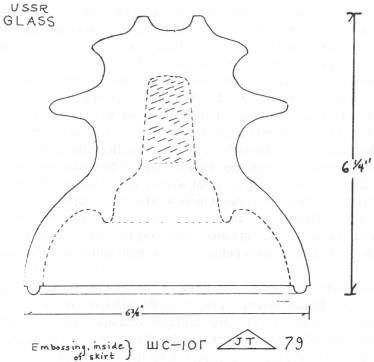
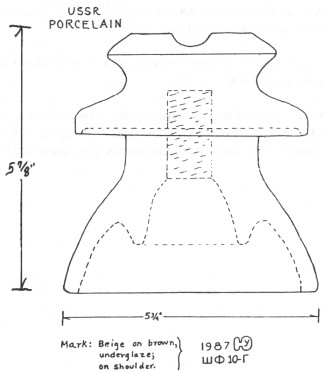
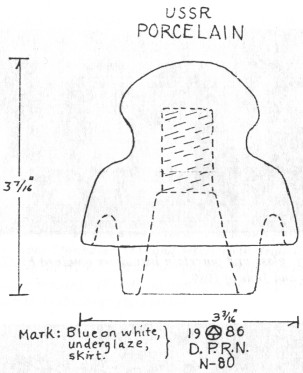
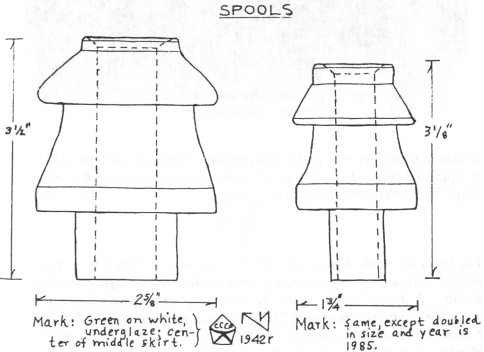
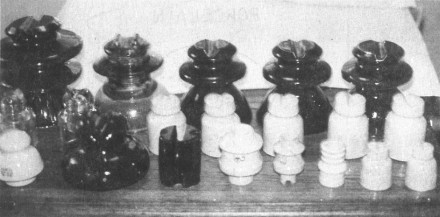
(Photo 1.) Twenty glass and porcelain insulators obtained by Fiene in the
USSR during May and June of 1989.
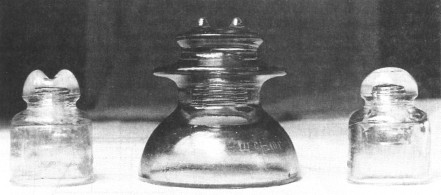
(Photo 2.) Only three were glass. The insulator on the left is similar to
CD-540, except that it measures 3-1/8 "x 4-1/4". It is sharply embossed
with distinctively Soviet high-voltage insulator logo:

The insulator on the right is the same, but it's turned 90 degrees to show
side profile. The large power insulator is unique. See accompanying drawing for
details. I do not know what the embossing means, except that it is an
interesting combination of both Cyrillic and Latin letters, and the date is
1979. A factory in a republic using the Latin alphabet (such as Estonia) might
well identify itself with Latin letters (that is, same as our letters).
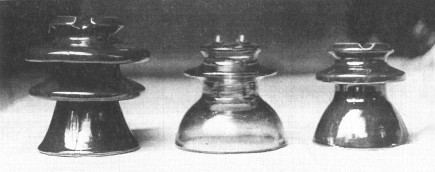
(Photo 3.) The three largest power types. The brown porcelain on the left is
a duplicate of one I found last year and described in detail in November, 1988
Crown Jewels of the Wire. That on the right also requires a new U-number. See
accompanying drawing. (For discussion of mark, see photo #5) See photo #2 for
information on the large glass power.
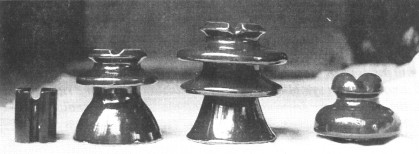
(Photo 4.) The four different types of brown porcelain obtained. The strain
on the left is virtually identical to that described in CJ (Nov.1988), except
that it is stamped in back on the bottom:

The large letter stand for "electricity" or some variation of it.
The medium-sized brown power type on the right is similar to one obtained and
described last year -- but not similar enough to sell. The only embossing is a date
on the skirt: 1961.
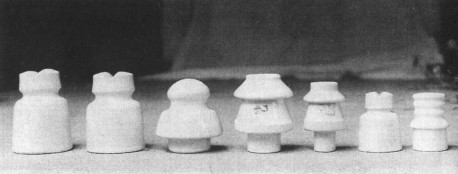
(Photo 5) The seven different types of white porcelain obtained. The
insulator on the far left is very close to U-1695. It has an incuse logo on
top:

This mark is a combination of the distinctly Russian letter " "
with the letter " "
with the letter " ".
I
don't know what they stand for, but they prove the insulator was made in the
USSR. On the other half of the top of this insulator is the incuse date: 88. The
companion insulator to the right has the same markings, except that the date is
given in full: 1981, and it is shorter, making it a U-1686. The next insulator
to the right is described in the drawings. It is similar to German and Polish
glass types. I do not know what the letters stand for in the mark, but the logo
in the center of the date, like a Christmas tree inside a circle, is a
distinctly Soviet symbol. The next two insulators to the right are fancy spools,
described in the drawings. The small pin insulator, similar to U-1633, except
that it measures 2 x 2-5/8 ",has the incuse marking on the top: ".
I
don't know what they stand for, but they prove the insulator was made in the
USSR. On the other half of the top of this insulator is the incuse date: 88. The
companion insulator to the right has the same markings, except that the date is
given in full: 1981, and it is shorter, making it a U-1686. The next insulator
to the right is described in the drawings. It is similar to German and Polish
glass types. I do not know what the letters stand for in the mark, but the logo
in the center of the date, like a Christmas tree inside a circle, is a
distinctly Soviet symbol. The next two insulators to the right are fancy spools,
described in the drawings. The small pin insulator, similar to U-1633, except
that it measures 2 x 2-5/8 ",has the incuse marking on the top:

The letters are the Russian equivalents of "K, D, Z." The number at
the bottom is the date (1970). The last insulator on the right is a sleeve or
bushing.

(Photo 6.) Black and white porcelain passenger-train sign: "Chelyabinsk
(a city in Siberia) to Moscow." 4"x 48"
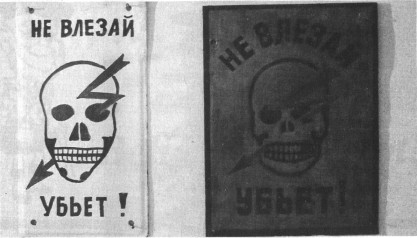
(Photo 7.) Porcelain high voltage warning sign "Climb and you die"
on left was obtained in 1989; the rusted and repaired iron sign on the right was
obtained in 1988.
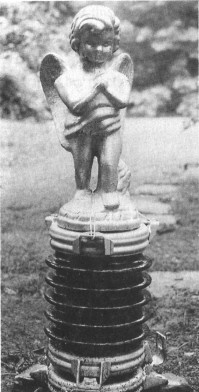
(Photo 8.) Large insulator, about 11" x 18", found in a ditch near
Wilmington, N.C. A flea-market, plaster, spray-painted angel is wired to THE
TOP.
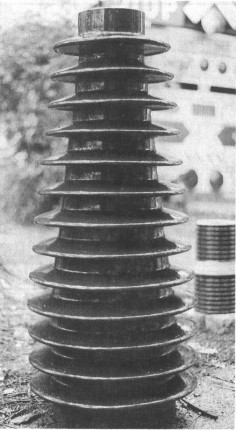
(Photo 9.) Giant insulator, one of 100 made in 1965 for a TVA
hydroelectric dam that was never built. 48" high; flags are 19" wide at bottom
and 14" at top. The core widens from 8" in diameter at top to 14"
at bottom. A local antique dealer is selling these for $100 each. I got mine at
the flea market for fifty. It weighs over 200 pounds. (How much bigger do
insulators come?)
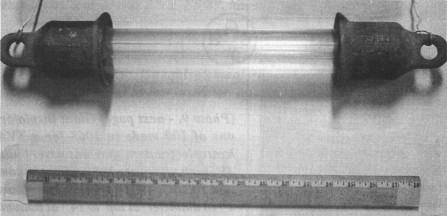
(Photo 10.) Large Pyrex antenna insulator bought from Chuck Haymond at the
Eastern Regional, Nashville, 1988. For more information on this type of
insulator, write Jim Singleton.
| 